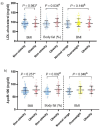Beyond BMI: a comprehensive approach to pediatric obesity assessment
- PMID: 40487022
- PMCID: PMC12142046
- DOI: 10.3389/fped.2025.1597309
Beyond BMI: a comprehensive approach to pediatric obesity assessment
Abstract
Background: Traditional Body Mass Index based obesity classification presents limitations in pediatric populations, particularly among physically active children. The 2025 Obesity Classification Framework proposed by The Lancet Diabetes & Endocrinology Commission integrates body fat distribution and metabolic biomarkers, aiming to enhance diagnostic accuracy in pediatric obesity.
Methods: We evaluated 111 physically active children (aged 5-11 years) from the Monterrey Football League in Mexico using both the traditional BMI-based classification and the new 2025 Obesity Classification Framework, which incorporates body composition (measured by bioelectrical impedance analysis), waist-to-height ratio, and metabolic biomarkers. Each participant was classified with both frameworks, and outcomes were compared against metabolic risk markers. Normality was assessed using the Shapiro-Wilk test. Non-normally distributed variables (fat mass, visceral fat, triglycerides, creatinine, and pCr) were analyzed using non-parametric tests, while parametric tests were applied for normally distributed data. Agreement between classifications was determined using Cohen's kappa coefficient.
Results: Agreement between classifications was moderate (κ = 0.532, P < 0.001). Using the new framework, 20 children previously classified as overweight by BMI were reclassified as having preclinical obesity, reflecting excess adiposity previously unrecognized. Conversely, four participants initially categorized as obese by BMI were reclassified as non-obese, reflecting elevated lean mass rather than adiposity. Participants categorized as having preclinical obesity exhibited significantly higher levels of LDL cholesterol and apolipoprotein B compared to non-obese peers.
Conclusions: The 2025 Obesity Classification Framework provides greater precision than traditional BMI-based assessments by effectively differentiating between excess adiposity and increased lean mass in physically active children. Although bioelectrical impedance analysis was selected due to its practicality, cost-effectiveness, and non-invasiveness, it has inherent measurement variability compared to dual-energy x-ray absorptiometry. Future research validating these results against DXA or other reference standards is recommended. Adopting this comprehensive assessment strategy may facilitate earlier and more targeted interventions for children at risk of obesity-related complications.
Clinical trial registration: https://doi.org/10.1186/ISRCTN12172320, identifier ISRCTN12172320.
Keywords: body composition; body mass index; childhood nutrition; metabolic health; pediatric obesity; physical activity.
© 2025 Ayuzo Del Valle, Pérez-Treviño, Cepeda Lopez, Murillo-Torres, Castillo, Gutierrez-Cantu, Tamez-Rivera, Paez Flores, Flores-Ayuzo, Luévano-Martinez, Fernandez Ortiz, García and Mancillas-Adame.
Conflict of interest statement
The authors declare that the research was conducted in the absence of any commercial or financial relationships that could be construed as a potential conflict of interest.
Figures




References
-
- Centers for Disease Control and Prevention. Child and teen BMI categories (2024). Available at: https://www.cdc.gov/bmi/child-teen-calculator/bmi-categories.html (Accessed February 24, 2025).
-
- Expert Panel on Integrated Guidelines for Cardiovascular Health and Risk Reduction in Children and Adolescents. Expert panel on integrated guidelines for cardiovascular health and risk reduction in children and adolescents: summary report. Pediatrics. (2011) 128(Suppl 5):S213–56. 10.1542/peds.2009-2107c - DOI - PMC - PubMed
LinkOut - more resources
Full Text Sources

